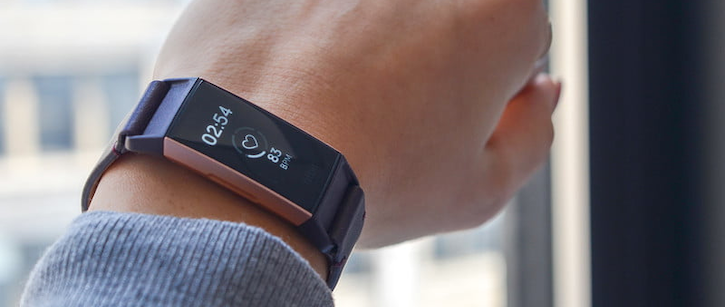Fitbit Is Pushing Its Way Back Into the Wearables Competition
The company is partnering with health plans, aiming to leverage the enterprise to bring its devices and personalized platform to more individuals.

Photo has been modified. Courtesy of Fitbit.
A few years ago, analysts claimed that Fitbit could be dying. But with a new focus on its platform and partnerships with health plans, the company seems to be squeezing its way back into the wearables and health data competition after all.
The latest example comes today, with Fitbit’s announcement that it will make available its Charge 3 — what it claims has the most advanced health and fitness features of any tracker — to UnitedHealthcare Motion participants.
In April, a Fitbit spokesperson told Inside Digital Health™ that the company wants to build on its platform to provide a more personalized and valuable experience for users. The company has also partnered with several health plans and related companies looking to leverage data to improve outcomes. For example, Fitbit has teamed up with Solera Health to reduce the risk of Type 2 diabetes, Blue Cross Blue Shield to offer devices to more than 60 million members through the Blue 365 program and Humana to offer Fitbit Care to its employer group segment.
It’s a different strategy than that of the Fitbit of old, which homed in on device sales and individual consumers. So far, the wearables company’s 2019 earnings suggest that the pivot is working.
“We saw continued momentum across the business and demonstrated that our focus and execution are leading to better results,” James Park, CEO, president and co-founder of Fitbit, said during an audio webcast with investors.
According to Fitbit’s 2019 first quarter financial results, its smartwatch sales increased 117% and its tracker sales increased 17% year-over-year, which reversed a multi-year decline for such devices. This shift may well be the result of the company’s push to integrate with health plans.
What’s more, Fitbit’s first quarter revenue totaled $272 million and saw a 10% revenue increase year-over-year, driven by both tracker and smartwatch growth. Fitbit also reported a selling decrease of 19% year-over-year to $91 per device. The company claims the price reduction lessened barriers for individuals to join its community of active users — and the new Fitbit is all about getting people to its platform.
So, to continue its rise, Fitbit plans to offer the Charge 3 as a buy-up option to eligible UnitedHealthcare Motion participants.
UnitedHealthcare Motion is an employee-sponsored wearable device walking program to encourage participants to move more and monitor their activity. Participants could earn more than $1,000 per year by meeting daily walking goals.
“Our strategy for long-term growth and profitability in our consumer business is to more effectively monetize our community of active users. Customer acquisition is the first step,” Park said.
UnitedHealthcare Motion is one example of how that might work. In the program, participants strive to complete three daily goals: to achieve 500 steps in seven minutes, six times a day and at least one hour apart, get 3,000 steps in 30 minutes and 10,000 steps in one day. If they meet the goals, they receive incentives.
On average, program participants log nearly 12,000 steps per day, which Fitbit claims is more than double the amount of the average American adult.
Fitbit is doubling down on this target user base, announcing that it plans to offer its Inspire HR to program participants later this year.
“Digital health solutions such as UnitedHealthcare Motion offer valuable and measurable benefits to help motivate and engage people to take control of their health journey,” said Paul Sterling, vice president of emerging products for UnitedHealthcare.
But with all of the health data that these devices collect, privacy concerns appear. Wearables and health data companies such as Fitbit could pull a page from direct-to-consumer genetic testing companies like 23andMe, which sometimes sell their consumers’ data. And any such technology can put user data at risk of being exposed in a cyberattack.
Providers are finding an increased use in the measurable benefits that come with wearable devices. The data collected can help physicians make better decisions and have more information about patients in between visits, according to a report by HIMSS Media. The devices allow for timely interventions, immediate feedback and improved patient accountability and empowerment.
Despite the amount of data being collected, physicians are often unsure what to do with the information. Many health systems lack protocols or systems in place to analyze the data being received. With little enterprise-level guidance, it’s questionable whether healthcare is getting the most out of wearables data.
Fitbit’s next move could be cleaning, organizing and sharing all of the gathered data so healthcare organizations can leverage it at scale.
Get the best insights in digital health directly to your inbox.
Related
Fitbit and NIH Launch Digital Health Tech Initiative for All of Us Program
Wearables Are Saving Human Lives. Can They Save Hospitals Too?
Fitbit Shows Promise in Tracking Performance, Predicting Cancer Outcomes